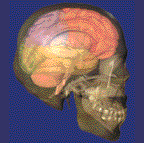 |
Muscle gene linked to human brain expansion |  |
 |
Muscle gene linked to human brain expansion |  |
|
By Melissa Lee Phillips Neuroscience for Kids Consultant September 2, 2004
Hansell H. Stedman and his colleagues at the University of Pennsylvania
looked at DNA samples from people all over the world. All humans
have the same mutated myosin gene and the same inactive form of the myosin
protein. All other primates tested, including wooley monkeys, pigtail
macaques, rhesus monkeys, orangutans, gorillas, bonobo chimpanzees and
regular chimpanzees, have full-length versions that make active myosin
proteins. Muscles are attached to bones, so changes in muscles can affect bone structure. Jaw muscles are attached to the skull. Therefore, jaw muscle strength affects the shape of the skull. Many scientists think that strong jaw muscles pull down and forward on the back of the skull. Stedman and his colleagues wondered if the weakening jaw muscle mutation they discovered could have allowed the skull bones of human ancestors to expand upward and backward. Their hypothesis was supported when they found out when the myosin mutation occurred. Using a genetic technique called molecular clock analysis, they found that the mutation in MYH16 occurred about 2.4 million years ago, in a primate species that was the ancestor of the human species (but that is extinct today). This date correlated with an important time in the fossil record. The first human-like fossil with a small jaw appears between 1.8 and 2 million years ago, and shortly after this, the first fossils with very large skulls appear.
The human brain is significantly larger than the brains of monkeys and apes. Our brains are much larger than those of chimpanzees, our closest relatives. Most scientists think that the enlargement of the human brain -- especially of the neocortex -- was a key step in the development of the technology, culture, and language that characterize us as a species.
"In principle, anything is possible when it comes to human evolution, since it only happened once," says Ajit P. Varki, a professor of medicine at the University of California in San Diego. "In practice, it is likely that many factors are involved in something like brain expansion."
Not all genetic differences between humans and other primates were significant in human evolution, Simpson cautions. "There are undoubtedly other gene sequences that distinguish us from apes, yet have no function," he says. "With the chimp genome near completion, is it increasingly clear that the answers about 'human uniqueness' are not going to come easy," says Varki. |
|
Did You Know?
|
|
For references and more information, see:
|
| GO TO: | Neuroscience In The News | Explore the Nervous System | Table of Contents |
![[email]](./gif/menue.gif) Send E-mail |
 Fill out survey |
 Get Newsletter |
 Search Pages |
 Take Notes |